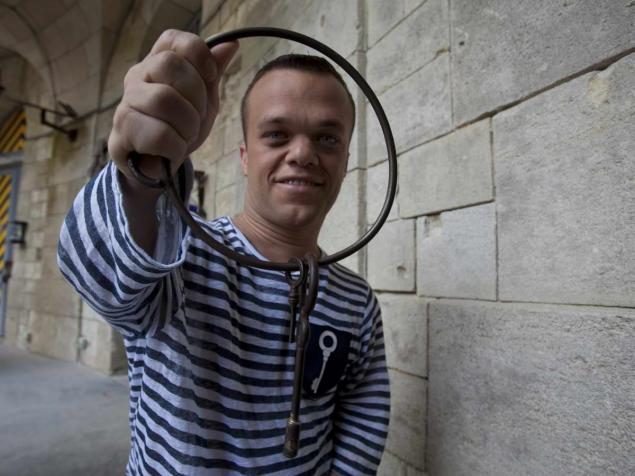127
Why Steve Jobs asked employees to imagine being thrown into a blender
Job seekers in Silicon Valley companies often have to answer unusual, and often very strange, interviewer questions. It is believed that this helps IT giants find employees who can think broadly and outside the box. For example, there are rumors that the legendary founder of Apple Steve Jobs used to introduce candidates into a stupor with a proprietary mystery: “You were thrown into a blender.” What are your next steps? ?

The full version of the question sounds somewhat different: “Imagine that you were reduced to the size of a five-cent coin and thrown into a blender.” At the same time, your weight has decreased so that the density of the body remains the same. The blades will start spinning in 30 seconds. How do you escape? ?

GettyImages Like so many other creativity challenges, this one also doesn’t have the right answer, but it does offer a whole range of solutions: satisfactory, good, and those that immediately follow the coveted “Congratulations, you’re accepted!”
Response options

All of the above answers give some hope, but in the long run, there is no chance of survival. After all, we do not know how long the blades will rotate and whether the blender will not fill with something. Preferably look the options providing escape from (Shoshank) blender.

These options are a little better, but those who voiced them, sin inattention to detail. Read the question again. In his text, an important key is hidden: density. So important is the weight of the body, its density and the physical laws by which they relate.
The answer Steve Jobs expected to hear is simple: jump out of a blender. But its justification is not very simple. How can you be sure that a smaller copy of you can do that? Let's figure it out.

Galileo wrote that “small animals are proportionally stronger and more enduring than large animals.” Some ants can lift loads up to 100 times their body weight. Would they be hundreds of times stronger than humans if they were enlarged to human size?
Nope! I will say more: perhaps such an ant and on his feet can not resist. The mass of any creature is proportional to the cube of its height. And muscle strength depends on the cross-sectional area of the muscles, which is proportional to the square of the height. In other words, increasing the size of an ant by a factor of 10 would increase its mass by a factor of 1,000 and its strength by a factor of 100.

The same is true of our mystery. Reducing a person’s height by 10 times, we will reduce the strength of his muscles by 100 times, but the mass will decrease even more – 1000 times. And if the usual ratio of strength to weight allows you to easily jump 30 cm (the height of the blender) in height, then the reduced you should jump out of the blender absolutely without straining.
However, all these arguments remain purely speculative. Only Marvel directors have learned how to reduce or increase living creatures so far. Unfortunately, we cannot test the theory in practice. Yes, this is by and large not required, the main thing is to demonstrate the ability to think creatively and find unusual solutions in any situation.
The article and the preview used photos.

The full version of the question sounds somewhat different: “Imagine that you were reduced to the size of a five-cent coin and thrown into a blender.” At the same time, your weight has decreased so that the density of the body remains the same. The blades will start spinning in 30 seconds. How do you escape? ?

GettyImages Like so many other creativity challenges, this one also doesn’t have the right answer, but it does offer a whole range of solutions: satisfactory, good, and those that immediately follow the coveted “Congratulations, you’re accepted!”
Response options

- Climb the blade and move to the axis of rotation. Find a place where you can maintain balance.
- Lie as tightly as possible on the bottom of the blender. That way the blades won't hurt me.
- Leaning against the glass walls. Perhaps there is a gap between the walls and tips of the blades thicker than a coin.

All of the above answers give some hope, but in the long run, there is no chance of survival. After all, we do not know how long the blades will rotate and whether the blender will not fill with something. Preferably look the options providing escape from (Shoshank) blender.
- Use the phone and ask for help. Um, why not? It is only unknown whether the reduced phone will work, how long you will have to wait for help and whether you will be nailed by the “assistants” with an old slipper, mistaken for a cockroach.
- Make ropes out of clothes and use them to get out. Well, it looks like you guys play too much computer games. To begin with, clothing has also decreased, and the height ratio of a five-cent coin to a stationary blender is at least 1 to 10. In ordinary life, this would correspond to 16-18 meters or the height of a five-storey house.
- Get out on the risks marking the volume, like a ladder. Theoretically, this is probably possible for some models. But, for example, on a glass of my stationary Braun blender strips go at intervals of 2 centimeters. And this, according to the terms of the task, is our full growth after the decrease. Climbing such stairs will be very difficult, it ends much earlier than the edge of the glass, and is applied to most models outside the blender. This path to freedom is not obvious.

These options are a little better, but those who voiced them, sin inattention to detail. Read the question again. In his text, an important key is hidden: density. So important is the weight of the body, its density and the physical laws by which they relate.
The answer Steve Jobs expected to hear is simple: jump out of a blender. But its justification is not very simple. How can you be sure that a smaller copy of you can do that? Let's figure it out.

Galileo wrote that “small animals are proportionally stronger and more enduring than large animals.” Some ants can lift loads up to 100 times their body weight. Would they be hundreds of times stronger than humans if they were enlarged to human size?
Nope! I will say more: perhaps such an ant and on his feet can not resist. The mass of any creature is proportional to the cube of its height. And muscle strength depends on the cross-sectional area of the muscles, which is proportional to the square of the height. In other words, increasing the size of an ant by a factor of 10 would increase its mass by a factor of 1,000 and its strength by a factor of 100.

The same is true of our mystery. Reducing a person’s height by 10 times, we will reduce the strength of his muscles by 100 times, but the mass will decrease even more – 1000 times. And if the usual ratio of strength to weight allows you to easily jump 30 cm (the height of the blender) in height, then the reduced you should jump out of the blender absolutely without straining.
However, all these arguments remain purely speculative. Only Marvel directors have learned how to reduce or increase living creatures so far. Unfortunately, we cannot test the theory in practice. Yes, this is by and large not required, the main thing is to demonstrate the ability to think creatively and find unusual solutions in any situation.
The article and the preview used photos.
Competent summer residents in spring treat currant bushes with ordinary soda, I take an example from them.
I love the smell of bread, especially gypsy.























